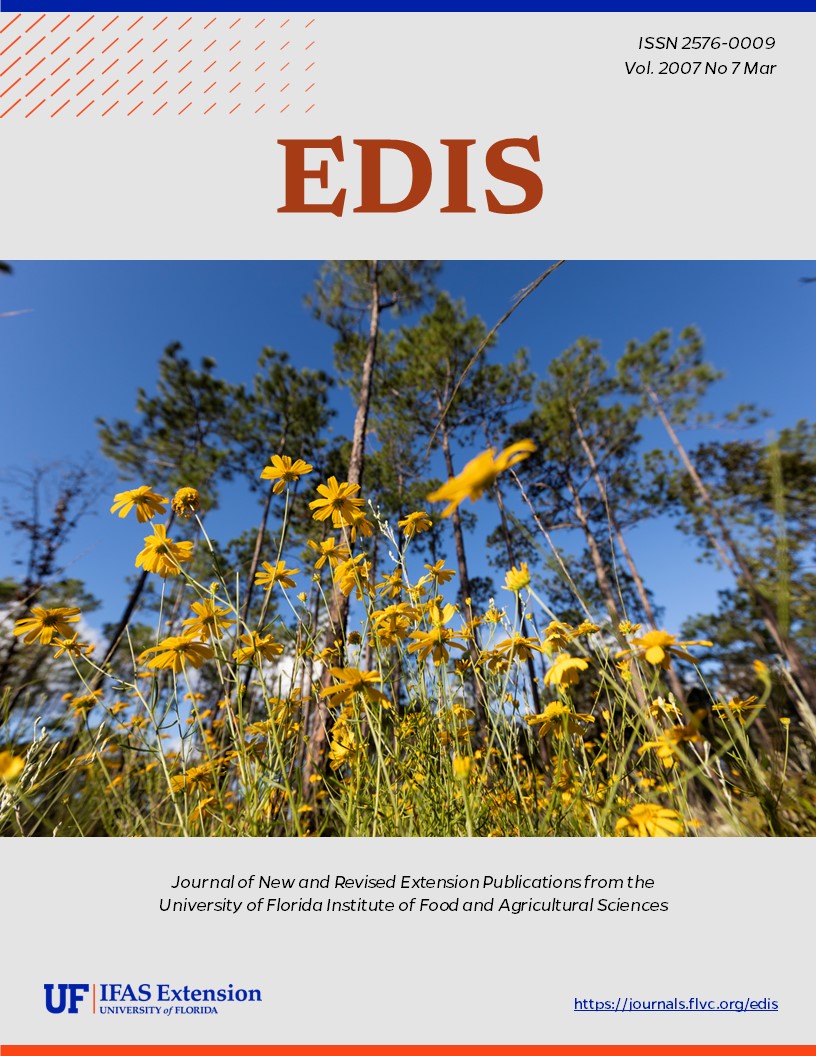Abstract
ENY-840, a 7-page illustrated fact sheet by Norman C. Leppla, describes this seasonally abundant nuisance pests also known as March flies, double-headed bugs, honeymoon flies, united bugs, ... and some expletives that are not repeatable. The author discusses several myths about these much-maligned creatures and describes some of the benefits they provide as well as tips for coping with them. Includes references. Published by the UF Department of Entomology and Nematology, January 2007.
References
Buschman, L. L. 1976. Invasion of Florida by the "Lovebug" Plecia nearctica (Diptera: Bibionidae). Florida Entomologist 59:191-194. https://doi.org/10.2307/3493971
Callahan, P. S. 1985. Dielectric waveguide modeling at 3.0 cm of the antenna sensilla of the lovebug, Plecia nearctica Hardy. Applied Optics 24:1094-1097. https://doi.org/10.1364/AO.24.001094
Callahan, P. S. and H. A. Denmark. 1973. Attraction of the "lovebug,"Plecia nearctica (Diptera: Bibionidae), to UV irradiated automobile exhaust fumes. Florida Entomologist 56:113-119. https://doi.org/10.2307/3493235
Callahan, P. S., T. C. Carlysle and H. A. Denmark. 1985. Mechanism of attraction of the lovebug, Plecia nearctica, to southern highways: further evidence for the IR-dielectric waveguide theory of insect olfaction. Applied Optics 24:1088-1093. https://doi.org/10.1364/AO.24.001088
Cherry, R. 1998. Attraction of the lovebug, Plecia nearctica (Diptera: Bibionidae) to anethole. Florida Entomologist 81:559-562. https://doi.org/10.2307/3495959
Cherry, R. and R. Raid. 2000. Seasonal flight of Plecia nearctica (Diptera: Bibionidae) in southern Florida. Florida Entomologist 83:94-96. https://doi.org/10.2307/3496234
Denmark, H. A. and F. W. Mead. 2001. Lovebug. University of Florida, IFAS, Entomology and Nematology Department, Featured Creatures, EENY-47. (http://edis.ifas.ufl.edu/IN204).
Dunford, J. C., J. M. Leavengood, Jr. and M. A. Branham. 2007. Additional notes on aposematic insects at Archbold Biological Station, Florida, with particular reference to the arrival of the lovebug, Plecia nearctica. Florida Entomologist (in press) https://doi.org/10.18474/0749-8004-43.3.337
Hardy, D. E. 1940. Studies in placeNew World Plecia (Bibionidae: Diptera). Part I. Journal of the Kansas Entomological Society 13:15-27.
Hardy, D. E. 1945. Revision of nearctic Bibionidae including neotropical Plecia and Penthetria (Diptera). Univ. Kansas Sci. Bull. 30:367-547.
Hardy, D. E. 1966. Family Bibionidae. In: A catalog of the Diptera of the Americas south of the United States. Departmento de Zoologia, Secretaria da Agricultura, Sao Paulo. 18:1-20.
Hetrick, L. A. 1970. Biology of the "love-bug", Plecia nearctica (Diptera: Bibionidae). Florida Entomologist 53:23-26. https://doi.org/10.2307/3493110
Hieber, C. S. and J. A. Cohen. 1983. Sexual selection in the lovebug, Plecia nearctica: the role of male choice. Evolution 37:987-992. https://doi.org/10.1111/j.1558-5646.1983.tb05626.x
IPM Florida. 2006. University of Florida, IFAS website: http://ipm.ifas.ufl.edu.
Jaeger, E. C. 1955. A Source-Book of Biological Names and Terms. Charles C. Thomas Publisher, Springfield, IL.
Kish, L. P., G. E. Allen, J. W. Kimbrough and L. C. Kuitert. 1974. A survey of fungi associated with the lovebug, Plecia nearctica, in Florida. Florida Entomologist 57:281-284. https://doi.org/10.2307/3493260
Leppla, N. C., T. C. Carlysle and R. H. Guy. 1975. Reproductive systems and the mechanics of copulation in Plecia nearctica Hardy (Diptera: Bibionidae). J. Insect Morphol. and Embryol. 4:299-306. https://doi.org/10.1016/0020-7322(75)90018-5
Leppla, N. C., J. L. Sharp, W. K. Turner, E. W. Hamilton and D. R. Bennett. 1974. Rhythmic activity of Plecia nearctica. Environmental Entomology 2:323-326. https://doi.org/10.1093/ee/3.2.323
Mousseau, T. A. 2004. Populations of the lovebug, Plecia nearctica (Diptera: Bibionidae) go unchecked by predators. Bull. Royal Entomol. Society. Antenna 28:78-80.
Pinto, L. G. 2002. Insecta - Diptera - Bibionidae. Fauna Amazonia Brasileira, Belem 17:1-16.
Sharp, J. L., N. C. Leppla, D. R. Bennett, W. K. Turner and E. W. Hamilton. 1974. Flight ability of Plecia nearctica in the laboratory. Ann. Entomol. Soc. Amer. 67:735-738. https://doi.org/10.1093/aesa/67.5.735
Thompson, F. C. 1975. "Lovebugs," a review of the nearctic species of Plecia Wiedemann (Diptera: Bibionidae). USDA, Cooperative Economic. Insect Report 25:87-91.
Thornhill, R. 1976a. Biology and reproductive behavior of Dilophus sayi (Diptera: Bibionidae). Florida Entomologist 59: 1-4. https://doi.org/10.2307/3493160
Thornhill, R. 1976b. Dispersal of Plecia nearctica (Diptera: Bibionidae). Florida Entomologist 59:45-53. https://doi.org/10.2307/3493168
Thornhill, R. 1976c. Reproductive behavior of the lovebug, Plecia nearctica (Diptera: Bibionidae). Ann. Entomol. Soc. Amer. 69:843-847. https://doi.org/10.1093/aesa/69.5.843
Van Handel, E. 1976. Metabolism of the "Lovebug" Plecia nearctica (Diptera: Bibionidae). Ann. Entomol. Soc. Amer. 69:215-216. https://doi.org/10.1093/aesa/69.2.215
Whitesell. 1974. Heat, sound, and engine exhaust as "lovebug" attractants (Diptera: Bibionidae: Plecia nearctica). Environmental Entomology 3:1038-1039. https://doi.org/10.1093/ee/3.6.1038

